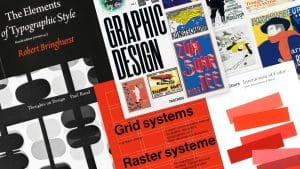How to Become a Graphic Designer: A Powerful Modern Skillset

Graphic design is everywhere around us, in myriad forms in our print and digital media. Graphic designers are the creators and authors of much of the visual world we see everyday. They develop aesthetically diverse advertising, entertainment, news, art and more, across a variety of mediums.
The road to success in a graphic design career looks a bit different for each individual and that can be a good thing in creative occupations. Those who go far in design tend to have a unique perspective, but most designers begin with some sort of training.
There is a wide range of jobs available around the world to skilled graphic designers. Marketing designers, UX designers, web designers, packaging designers, branding designers, and video game designers are just a few creative careers a trained designer can explore. Graphic designers do anything that relates to communicating using images, typography, color, and layout.
Learning how to become a graphic designer online opens flexible pathways for beginners, experienced professionals, and career switchers. Read on for the steps you need to take to start fresh or level up.
IN THIS GUIDE:
How To Become a Graphic Designer: Step by Step
What is a Graphic Designer? What Do They Do?
First things first. What exactly is a graphic designer? According to the American Institute of Graphic Arts AIGA, the professional association for design, graphic design is “the art and practice of planning and projecting ideas and experiences with visual and textual content.” With such a profoundly creative and versatile career path, the sky is truly the limit!
In a more practical sense, designers use their skills to make visual content or concepts for brands, organizations, and media. They design original, thought-provoking content to be used in advertising, social media and other forms of communication.
It’s about taking a message or concept and translating it into imagery that is consistent with an organization’s or client’s branding and goals. Think of all the major brands and logos you know. Now think about how exciting it could be to directly contribute to the success of your favorite brand’s identity. Imagine seeing your creative work empowering an organization or making a difference in the lives of everyday people.
Career Paths for Graphic Designers
As creative visual communicators and thinkers, designers are widely needed across a number of areas. Using design elements like images, color, and typography, they design logos, websites, marketing materials, and other digital art that speak to the viewer. Our modern world is engulfed in digital and print imagery created by designers. This trend is not likely to change in the near future.
You can find graphic designers employed in virtually every industry. Here are just a few:
- Advertising and Marketing
- Game Development
- Entertainment
- Fashion and Apparel
- Publishing
- Interior Design
- Museums and Curated Galleries
- Event Planning
Why Pursue a Career in Graphic Design?
There are many personal and professional reasons to pursue a graphic design career. The act of creating is a reward in itself, but it can also be a worthwhile venture to make a great living. While the demand for employees in this sector waxes and wanes, almost every business needs a graphic designer at some point.
According to the AIGA, the purpose of design is to “improve the visual appearance and function of messages and information.” Designers can work as part of a team in a creative agency, as an in-house designer at a company, or as a freelance designer who sets their own schedule. Whatever your motivation, there are plenty of reasons to choose a career in design.
A graphic design career offers creativity, flexibility, and a chance to solve visual challenges. Some of the most successful designers are adaptable, processing strong attention to detail and time management skills, as well as a passion for creative, visual communication. If you enjoy creativity and problem-solving, it’s a great career path. A graphic designer salary varies and offers good earning potential.
How To Become a Graphic Designer: Step by Step
Now that we’ve made the case for becoming a graphic designer, let’s go over how you can kickstart your graphic design career. It may seem like a daunting task initially, but rest assured you can do this!
Every graphic designer has taken a slightly different path to arrive where they are. Nevertheless, there are some things you can do to increase your chances of succeeding in the field.
Here’s a detailed guide to becoming a graphic designer whether you’re just starting out, looking to advance your career, or looking to switch careers.
1. Learn Design Fundamentals
Mastering the basics is the first step toward a design career. Regardless of your education level, you start exploring the field by taking a design course. Graphic designers need to have a keen eye and a creative brain, but they also need to develop skills and software fluency. Practice in a safe educational setting will challenge you as well as help you become comfortable in a number of areas.
Just Starting Out or Switching Careers
Seek ways to learn principles of design like layout, typography, and color theory, as well as how to combine these elements into impactful visuals. If you’re in high school, taking art and design courses now will help to improve your chances of being admitted to a program later. You might begin begin work on creating a portfolio of work; you can find more information on portfolios below.
Outside of formal education courses, there are many other ways to develop your graphic design skills. A membership to the American Institute of Graphic Arts immediately opens several doors to help you hone your talents with their trusted graphic design resources. From free-to-members webinars and access to local community chapters to entire archival collections for inspiration, the AIGA serves as a central hub for anyone pursuing the field of graphic design.
Another source of free, accessible resources is the Graphic Artists Guild, which supports graphic designers by providing resources like digital contract templates, educational webinars, and professional development events. They offer helpful tools for freelancers, including information on running a creative business.
Advancing your Career
You don’t have to stagnate in your professional development. You can use the skills you already have and build on them. Even if you are comfortable with your skills and abilities, keep going and define your voice in the mediums you use.
Challenge yourself to learn new skills that you may have difficulty with. Is there a new program or tool you’re interested in? Or maybe a certain skill you need to acquire to land your dream job? Practice, practice, practice. You will improve over time and that will help you obtain professional success.
Professional development looks different for everyone, especially those who already have a full time job and a busy life. If you’re pressed for time, consider adding AIGA’s design podcast Margins to your morning routine or drive home. Each episode discusses emerging practices, civic engagement, sustainable transitions, competitive markets, and more.
2. Pursue Education and Certifications
Not long ago, a strong portfolio and some determination was all a person needed to pursue a career in design. That time is over. Employers want to see evidence of a well-rounded education in prospective employees.
Formal education is essential in this career. For more advanced roles, employers often prefer a Bachelor’s degree. Arts accrediting organizations like the National Association of Schools of Art and Design (NASAD) help define the standards for Bachelor’s degrees in the creative majors. Taking graphic design courses can prepare you for the design world’s practical challenges. From certificates to degrees, education adds credibility.
Additionally, a degree is far more than a simple piece of cardboard, it is a symbol of your work, determination, and reliability. There are many tasks and obligations associated with earning a degree. If you have a degree, you have been mentored, even tested, by experts in the field and been found capable, if not extraordinary.
Just starting out or switching careers?
Educational institutions are quite prepared to show you the way to your personalized career track. Admissions advisors are trained to guide people from all types of backgrounds and experience levels.
If you’re looking to switch careers, building a foundation in a program like the Sessions College Professional Certificate in Graphic Design is one of the best ways to help you transition. Certificate programs are designed for adult learners and can be completed in a matter of months. Hands-on learning and project-based coursework can help students graduate with real-world experience and a portfolio of work that is the first step to a more creative career or professional role.
Advancing your career?
Already have a degree? You can benefit greatly by earning a focused certificate or a more advanced graphic design degree. If you are self-taught, obtaining a Bachelor’s Degree or higher can help you build more skills and may increase your earning potential. Earning a higher degree will only make you stand out among your competitors. Upper-level positions may require a graduate-level degree like a Master’s degree, as well.
3. Build a Portfolio
Curate a portfolio demonstrating the best of your skills. A strong portfolio showcases a diverse range of work. Remember to keep it simple and place your best work front and center. Quality is better than quantity in this case. If you’re having trouble simplifying your portfolio, consider some of your specialized skills. Choose an area of specialization and construct your portfolio around that strength.
Just starting out or switching careers?
One of the most important things you’ll need before you set off to find work is a solid design portfolio. As you begin to build your portfolio, consider which formats will best suit your work and needs. Many designers have both online and print portfolios with overlapping work. If you’re using the same pieces in multiple formats, be sure to include some new stuff that will continue to wow the viewer.
AIGA offers some incredible graphic design resources that can help you build your portfolio. Building on a 60-year legacy, GDUSA provides resources such as design competitions, online education, job listings, and newsletters to help graphic designers stay updated with trends and enhance their portfolios. It also publishes educational content through its magazine and website, focusing on insights within the industry.
Advancing Your Career?
Brush up on your existing skills, and learn new, in-demand design skills, like social media content creation . These are accomplishments you can put directly on your resume or in your portfolio. A portfolio may be the best way to demonstrate your abilities to a future employer outright. So even if you don’t have years of experience on your resume, a strong portfolio can be enough to get your foot in the door. Consider trying your hand at some freelance gigs or volunteering your time toward an area you’re passionate about.
4. Find Your Style and Space
Competition for design jobs has increased in recent years. In order to be successful, designers can define themselves in a niche or specialization.
Here are some areas of specialization you may want to consider:
- Advertising and Marketing
- Web Design
- Logo Design
- Multimedia Design
- Motion Graphics Design
- Print Design
- Packaging Design
- Environmental Design
Aside from a specialization, designers need to develop a style that is consistent and sets them apart from others in the field. Clients and employers like to know what they can expect and will seek out designers who can bring their vision to life.
5. Complete Design Internships
Internships are a great way to get real-world experience at an entry level and create professional relationships. Some internships are even paid positions! If you can, take advantage of internship opportunities. Think of them as stepping stones in the beginning of your career path. Check out AIGA’s Guide to Internships for some inspiration!
6. Stay Current With Design Trends and Technology
Whether you’re looking to advance your existing career, switch careers, or are just starting out as a graphic designer, it’s important to continually refine your graphic design skills and familiarize yourself with new tools. Practicing on platforms like Adobe Creative Cloud or exploring AI design tools can give you an edge.
Few fields change as often as graphic design. The software and tools are constantly updating and evolving. Designers have to keep up with the changes to be competitive and ensure they have the best and newest tools at their disposal.
Depending on your specialization, here are some tools you can familiarize yourself with:
- Designers: Adobe Illustrator, CorelDraw Graphics Suite
- Web Designers: Adobe XD, Adobe Dreamweaver, InVision, Sketch, Brackets, Atom
- Print Designers: Adobe Indesign, Scribus
- Motion Graphic Designers: Adobe After Effects, Autodesk Maya, CINEMA 4D, MoGrap
A designer can always be working on improving their portfolio, gaining a new skill, or networking and attending events to stay current with trends and technology. And if you’re considering beefing up your creative, video, technical, and motion graphics skills, consider the Sessions College Professional Certificate in Multimedia Arts!
Practical Tips for Building a Strong Graphic Design Portfolio
As mentioned, every designer needs a strong portfolio. As one of your most valuable promotional tools, it’s a crucial step you must complete before you set off on your career. Use this checklist to help you create a compelling presentation of your work that will have prospective employers eager to connect with you.
1. Select Your Best Work
Choose design projects that illustrate your abilities and establish your credibility. Remember: quality over quantity! Unless your personal design style is flashy and loud, keep the interface simple and allow the content to speak for itself. Include pieces demonstrating design thinking, problem-solving skills, and creativity.
Consider creating multiple portfolios that are tailored to different job types if you’re pursuing careers in multiple design spaces. While most portfolios are digital these days, you may want to consider utilizing print formats and physical media when applicable. No matter the format, it’s important to ultimately make sure your portfolio is clean, user-friendly, and highlights your most brilliant work.
Additionally, update your portfolio regularly to stay fresh and relevant. Include samples for a diversity of projects that exhibit your ability to work within a variety of industries and media. Demonstrating the breadth of your experience through different types of project samples shows future employers that you’re versatile and adaptable.
2. Choose Typography Wisely
Select readable fonts that align with your brand identity, and limit font choices to a few complementary styles. Maintain a cohesive look across your portfolio to avoid overwhelming viewers. Typography is a huge aspect of graphic design, so it’s important that you’re showcasing your understanding of its best practices.
3. Incorporate Modern UX/UI Techniques
Exhibit your understanding of user experience (UX) and user interface (UI) design. If applicable, present your work with responsive design examples. Demonstrating adaptability across devices shows you value accessibility.
Incorporating these modern techniques also shows that you’re forward-thinking and up-to-date on current technologies. For example, if your digital portfolio doesn’t respond to different mobile screen sizes, this will likely be a red flag to potential employers—especially those in the web design and marketing industries.
If you’re interested in sharpening your UX/UI skills, check out our online UX/UI Design course.
4. Tell a Story with Engaging Case Studies
Creating an impressive graphic design portfolio doesn’t end after you’ve compiled your best images and screenshots. It’s also imperative that you’re showing viewers what your work has achieved and how. You can do this by incorporating case studies detailing your creative process, challenges, and your work’s impact, giving potential employers or clients a peek behind the curtain to understand your approach.
While you don’t have to include a case study for every portfolio item, it’s useful to always give your viewers more context on the purpose of the piece and its impact on the client, organization, or customers that utilize it.
For example, consider combining images of your designs with mockups or user scenarios to illustrate your work functioning in real-world settings. However you end up presenting your portfolio, make sure there’s a clear story that conceptualizes your work and illustrates a quantifiable reason to hire you for the job.
5. Promote Yourself Effectively
The art of self-promotion is central to the portfolio-building process. Whether you want to be self-employed or work for a company, you’ll need to be able to quickly showcase your skills and abilities. Share your portfolio via social media, on your website, at networking events, and on industry forums. If you have business cards, consider adding a QR code that directs users to a mobile-friendly version of your portfolio.
Whichever platforms you choose, be sure to project confidence. You know your work inside and out, so it may be easy to see the negative aspects of it. Avoid negative thought patterns or imposter syndrome. Practice describing your work and marketing yourself using positive, upbeat language. Create and maintain a personal brand that reflects your style and values and then be fearless in showing it off.
6. Evolve Continuously
A professional portfolio is never really done, just constantly headed towards perfection. Keep your portfolio updated and aligned with your growth. Refine your work through peer and mentor feedback.
Long-term success hinges on ongoing learning and adaptation to new trends and technologies. As you continue to hone your old skills and add new ones, your work will change. This is how designers increase their value and keep themselves relevant. Things change quickly, especially in the digital space. Stay current!
Interested in learning more? We love these design portfolio tips from AIGA!
Graphic Design Job Outlook in 2025 and Beyond
The design future looks promising. Many designers work as freelancers for the personal freedom it provides, while others prefer structured, agency roles where they can collaborate with other team members and work on larger teams.
The median pay for graphic designers in 2023 is around $58,910 per year. The typical work environment for a designer is a studio with computers, drafting tables, software, and other a range of art making tools. Many designers work independently, but often they are part of a design team. Collaboration among and between groups is also common for designers, as they are often needed to bring a visual or communications perspective to an organization or project.
| Date | Statistic* |
| 2023 Median Annual Pay | $58,910 |
| Typical Entry-Level Education | Bachelor’s degree |
| Number of Jobs, 2023 | 267,200 |
| Job Outlook, 2023-33 | +2% |
| Employment Change, 2023-33 | +6,600 |
Graphic designer facts: U.S. Bureau of Labor Statistics.
Jobs You Can Pursue With a Graphic Design Degree
Although the job titles, descriptions, and requirements will vary greatly, graphic designers today tend to create visual concepts using computer software programs such as Adobe’s Creative Cloud suite (Photoshop, Illustrator, InDesign, and so on), in combination with traditional art-making tools for drawing, painting, illustration, or photography.
Designers communicate through imagery in order to inform, inspire, or captivate. As we just discussed, a degree can help you fast-track your way to landing your first gig or dream graphic design job.
With that in mind, here are brief descriptions of some of the most popular graphic design career choices we’re seeing today.
Graphic Designer
Graphic designers, also referred to as communication designers or graphic artists, use imagery to communicate. They creatively fuse art and technology to create the look and feel of our websites, apps, and printed media.
Wherever information must be communicated, a designer is essential. Designers create visual messages with text and images, making decisions on anything from the font size on a pamphlet to the layout or design of a webpage. Often they will specialize in a specific type of client or product.
Some typical responsibilities for a graphic designer may include:
- Meeting with stakeholders or art director in project development
- Editing or reviewing concepts prior to publishing
- Create imagery such as logos, illustrations, or infographics to communicate a message
- Design layouts for projects and images (color, typefaces, images, and so on)
One exciting thing to note here is that the Bureau of Labor Statistics predicts a growth of 15% for web designers in the next decade. That’s an additional 24,400 new positions! The growth for graphic designers is only predicted to grow 4% in the upcoming decade, which is an additional 11,000 new positions. Something to consider when you’re determining which path you’d like to take!
Art Director
The title Art Director is quite descriptive of the duties and responsibilities related to this career. As it may sound, art directors are responsible for the visual and image representations of organizations and their products. They may manage teams or collaborate with designers and other staff for marketing concepts and visual effects.
The vast majority of art directors are self-employed (56% according to the Bureau of Labor Statistics), though many are employed by advertising or other creative firms.
Art directors may have some of the following tasks as part of their purview:
- Presenting designs to teams or client
- Managing the overall style or look of an advertising campaign or publication
- Manage the look and feel of film, theater or television sets
- Coordinating projects with creative departments or teams
- Developing project budgets
- Managing creative teams of artists, set designers, graphic designers, et al.
The Bureau of Labor Statistics also predicts growth for art direction jobs in the next decade. At a growth of about 5%, that’s an additional 4,900 new positions expected to be created.
Production Artist
A Production Artist is a creative who is responsible for actually executing the processes of a design concept. They are not as involved with the brainstorming, or ideation portion of the design process as graphic designers, but are heavily involved in the actual visual creation process associated with the product or concept.
A production artist may be involved with the production of packaging, advertising concepts, film sets, and any number of other creative projects an organization may endeavor to create.
Some of the tasks a production artist may perform are:
- Creating presentations for teams or clients
- Preparing images for websites or web applications
- Troubleshooting problems that a creative team may have
- Making multiple iterations of a concept or artwork
- Resolve artwork issues that arise during production/prototyping
- Retouching images and other image manipulation prior to publication
- Producing set designs for film or theater
Similar to the art directors and graphic designers, the Bureau of Labor Statistics also predicts around 5% growth for production artists in the next 10 years. That’s around 2,400 new jobs per year.
Logo Designer
Logo (or logotype) design is a simple yet profound test of professional skills for any designer. A Logo Designer creates branding imagery to symbolize a product or brand using typography and graphics. This is one of the most important design aspects a company may consider, as these branding elements are designed to be instantly recognizable.
Creating a great logo or branding materials can take an entire team of individuals. If you’re looking for a career in logo design, be prepared to collaborate across organizations. Logo designers must have strong design skills and be able to learn the newest techniques and tools.
While the Bureau of Labor Statistics doesn’t specifically report on the outlook for logo designers, you can assume it’s similar to that of graphic designers outlined above due to the skills and expertise overlap.
Marketing Specialist
Marketing Specialists have such varied tasks from one situation to another, it is hard to pin down a solid description that will describe the occupation well. They may be entirely involved with marketing analytics, data, and strategy or they may have some creative aspects in their role.
A marketing specialist creates and manages marketing endeavors to reach audiences using a variety of communication tools and methods. They may have to be knowledgeable in print media, web marketing, film, television, and radio, among other forms of communication.
Some of the duties a marketing specialist may have are:
- Providing creative input/feedback to marketing projects
- Analyzing consumer and competitor data
- Creating project messaging and concepts
- Collaborating with marketing, sales, and product teams on new products or advertising
- Researching current marketing practices and strategies
- Reporting analytics to clients or management
Marketing managers and specialists are expected to grow faster than the average for all occupations at 8% over the next decade, according to the Bureau of Labor Statistics, with an addition of around 36,000 new positions each year.
Related Fields
Some careers are very similar or adjacent to graphic design, but not considered a part of the field, necessarily. Still, you would benefit from having training or skills in design if you were in one of these related fields.
Here are some careers that are related:
- Layout Artist
- Brand Identity Designer
- Multimedia Designer
- 3D Modeler
- Architecture & Engineering Drafter
- Computer Animator
- Video Game Designer
- Web Designer
- Web Developer
- Interior Designer
- Product Designer
Graphic Designer: Frequently Asked Questions
Q: What Education is Required to Become a Graphic Designer?
You may be wondering, what kind of education does it take to become a graphic designer? There isn’t a simple answer to this because people take different routes through their career journeys. Some designers have decades of education, while others may have very little outside of high school.
According to the Bureau of Labor Statistics, graphic designers “usually need a bachelor’s degree in graphic design or a related field” to be hired to a full-time position, though some may be able to enter the field without a credential if they have a strong enough portfolio to back them up.
The bottom line is that a designer’s skills and talent, in addition to their ability to work in a team, are usually the areas of focus for potential employers. And while a degree program cannot guarantee you will develop those areas of proficiency, it can provide a structure for aspiring artists and designers to raise their game.
High school students who may be interested in design should take art and design courses. Some degree programs may require the completion of art or design courses before being admitted. Sketches or other examples of other work may be required as well.
Q: Why is a Graphic Design Degree Important?
A degree is just a piece of paper, right? Research continues to support the enduring value of earning a degree and what it communicates to employers. The value is in the education itself.
When someone earns their degree through an accredited program, not only do they learn skills specific to their focus, but they also learn transferable skills that employers are looking for such as effective communication, critical thinking, being a team player, and adaptability. In addition to learning these multidimensional skills, a Bachelor’s degree also demonstrates reliability and the willingness to stick with something even if it requires hard work and a multi-year commitment.
While you may already have these skills without a degree, it’s often much harder to prove. Employers tend to look for candidates with degree-level education because of the reasons outlined above. In fact, according to the College Board Education Pays 2023 report, unemployment rates for individuals who were at least 25 with a 4-year degree in 2021 experienced half the unemployment rate of those who only graduated high school.
Q: How Can Sessions College Help? Preparing for a Successful Graphic Design Career
Graphic design is a rewarding field offering endless opportunities for creativity and growth. Whether you’re a newcomer, an experienced professional, or someone transitioning from another career, we hope this comprehensive career guide will help you achieve your goals.
This guide is brought to you by Sessions College. We’d like to share a few final thoughts before you head on your way.
We know that there are many things to consider when choosing the best graphic design school for you. Accreditation is important. Make sure any school you are considering is accredited. Accessibility and the ability to fit into your schedule is also important. Remember, you may be setting yourself up to fail if you don’t consider how a curriculum and classwork will fit into your existing time commitments.
Here at Sessions, we are a fully online, accredited school of art and design offering a dynamic range of degree and certificate programs in Graphic Design and related fields. Accessibility and flexibility is a top priority for us, and that’s why we provide a range of options for students from self-paced certificate programs to degree programs with financial aid funding. Talk to an Admission Advisor to find out why GDUSA has rated Sessions College a top design school nine years in a row.

Laine Hissett is an audio journalist and commercial writer with a strong background in writing procedures and business correspondence. Read more articles by Laine.
RELATED ARTICLES:
SESSIONS NEWS:
ENROLL IN AN ONLINE PROGRAM AT SESSIONS COLLEGE:





